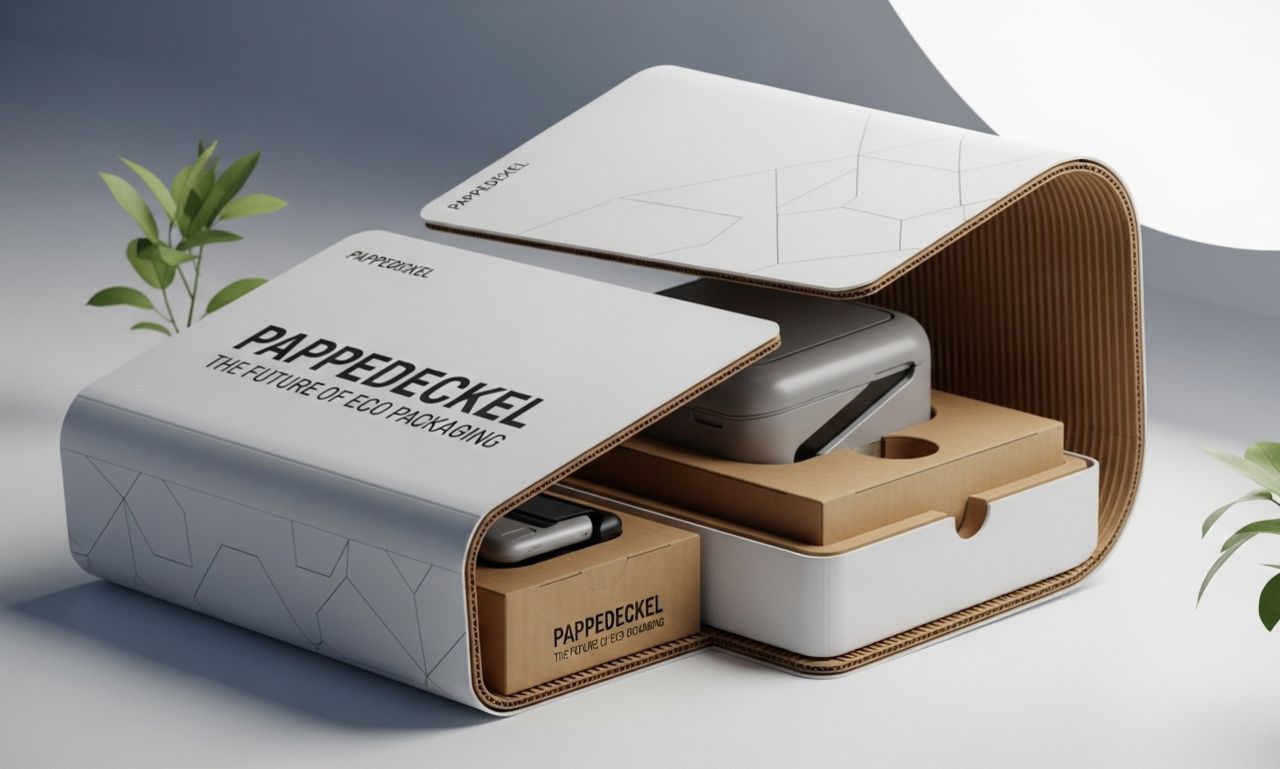The term Pappedeckel appears more and more in the discussion around packaging, sustainability and branding. In this article we’ll explore what a Pappedeckel is, the origins of the concept, how it is used today, its environmental benefits, design implications, market challenges and its promising future. If you’re interested in eco-friendly packaging solutions or just curious about how something as simple as a cardboard lid can matter, read on.
Understanding Pappedeckel
What exactly is a Pappedeckel? The German word combines Pappe (cardboard) and Deckel (lid or cover).
In practice, it refers to a lid or cover made of cardboard or paper-board, commonly used for containers, cups, jars and other packaging formats.
So when you see a container sealed with a firm paper-lid instead of a plastic one, you may well be looking at a Pappedeckel.
Because the concept is straightforward yet impactful, it’s worth diving deeper into its meaning and potential.
Historical roots of the Pappedeckel concept
Although the word Pappedeckel may sound modern, cardboard covers have been in use for decades.
The early usage of “Pappendeckel” in German simply meant stiff paper or cardboard sheets.
The shift toward their use in everyday packaging, especially as a sustainable alternative to plastic, gained momentum in recent years as awareness of waste and recycling grew.
In Germany and other European countries where waste separation and recycling are well established, the transition to cardboard lids rather than plastic was more feasible. Thus the Pappedeckel concept was born and is now spreading to other regions.
Why the Pappedeckel matters in packaging
There are several compelling reasons the Pappedeckel is rapidly gaining recognition:
-
Eco-friendliness: Cardboard is biodegradable and recyclable. Unlike many single-use plastics, it breaks down more easily and fits well into circular economy models.
-
Cost-effectiveness: Using cardboard rather than complex plastics can often reduce manufacturing complexity and waste.
-
Branding & design flexibility: A Pappedeckel can be printed, shaped, textured, or coated with plant-based layers, offering companies a platform for brand messaging as well as functional performance.
-
Lightweight & transport-friendly: Since cardboard is lighter than many plastics or metals, transport costs and environmental impact can be reduced.
When packaging decisions matter to consumers (and increasingly they do), choosing a Pappedeckel over a less sustainable lid sends a message of responsibility, and that can translate into customer loyalty.
Common applications for Pappedeckel
Where do we find Pappedeckel-style lids being used? The applications are varied and growing:
-
Food & beverage containers: For hot cups, takeaway bowls, dessert tubs, coffee shops often use cardboard lids rather than plastic.
-
Bakery boxes / meal trays: Cardboard covers serve well for pastries, salads, meals on the go.
-
Consumer goods packaging: Beyond food, small jars, cosmetic containers, craft kits may use cardboard lids. Custom shapes and printed designs make the Pappedeckel viable for non-food sectors.
-
DIY, crafts and household utility: Some people repurpose cardboard discs or lids as coasters, protective covers, or craft materials.
Each of these uses demonstrates that the Pappedeckel is not just a minor detail—it is a functional and visible part of the packaging ecosystem.
Benefits of Pappedeckel in sustainability & business
Environmental benefits
- Cardboard made from recycled or responsibly-sourced fibers reduces reliance on virgin plastics.
- Moreover, the biodegradability and recyclability of the material therefore mean less waste in landfills and consequently less persistence in the environment.
-
Lower carbon footprint: The life-cycle of cardboard lids uses less fossil fuel and energy compared with petroleum-based plastics.
-
Encourages consumer awareness: When packaging is visibly eco-friendly (e.g., a cardboard lid), it signals to buyers that the brand cares.
Business and brand benefits
-
Brand differentiation: By adopting Pappedeckel, companies stand out in competitive marketplaces.
-
Marketing potential: The lid itself becomes a communication vehicle: printed logos, eco-messages, QR codes, or custom shapes enhance brand experience.
-
Cost savings: Lightweight, recyclable materials reduce shipping and disposal costs.
-
Regulatory advantage: Using a Pappedeckel mitigates risk from future plastic bans or environmental regulations.
Design and material considerations when using Pappedeckel
Material selection and coatings
A Pappedeckel must often resist moisture, oils, heat (in the case of hot drinks) and folding stresses. Thus, cardboard alone may need a plant-based coating or lamination to enhance performance.
The choice of paperboard grade, recycled content, thickness and structure matters.
Die-cutting and custom shapes
For a tight fit and effective sealing, Pappedeckel lids must be precision-cut and correctly sized. Customised shapes (round for cups, rectangular for trays) may increase tooling cost but enhance brand fit.
Printing & branding
Because these lids are visible and often part of the visual packaging, printing quality, colour fidelity and ink type (food-safe, eco-certified) should be considered. The design must not compromise recyclability.
Performance in use
Supply chain and disposal
The entire lifecycle should be assessed: sourcing of raw material, manufacturing, shipping, consumer use, and end-of-life disposal (recycling / composting). If a Pappedeckel cannot be recycled easily in the target market, its sustainability benefit may be reduced.
Challenges and limitations of Pappedeckel adoption
Despite its many benefits, the Pappedeckel is not without challenges. Awareness of these helps in making informed decisions.
-
Initial investment and tooling cost: Custom cardboard lids may require new dies, machinery or vendor changes which raise upfront costs.
-
Consumer awareness: In some markets, consumers may not recognise a cardboard lid as equivalent in performance to plastic or may mistakenly discard it.
-
Performance constraints: For certain high-moisture, hot or oily products, a simple cardboard lid may not suffice without additional treatments (which may complicate recyclability).
-
Supply chain transition: Shifting from existing plastic lids to Pappedeckel formats can disrupt current supply chains.
-
Recycling variability: The effectiveness of recyclability depends on local recycling infrastructure.
Recognising these limitations allows brands and packaging engineers to plan for them, rather than being surprised later.
Future trends and innovations in Pappedeckel development
The future of the Pappedeckel space is bright and evolving. Several trends are emerging:
-
Advanced coatings and barrier materials: Biodegradable coatings enhance moisture or grease resistance without sacrificing recyclability.
-
Smart packaging integration: Incorporation of QR codes or printed electronics on the lids to engage consumers or provide product information.
-
Customization and limited-edition branding: Brands are using Pappedeckel as a canvas for campaigns, seasonal editions, or limited prints.
-
Market expansion across sectors: Beyond food & beverage, expect greater adoption in cosmetics, household goods, DIY kits and specialty merchandise.
-
Global adoption and standard-setting: As more regions impose plastic bans or stricter packaging waste regulations, the adoption of cardboard lids like Pappe deckel will accelerate.
-
Consumer behaviour reinforcing demand: As consumers become greener, they will expect visible packaging cues; the Pappedeckel is one such cue.
How businesses can implement Pappedeckel successfully
-
Assess packaging requirements: Determine needed performance and whether a cardboard lid meets those specs or requires coating.
-
Engage vendors and production partners: Identify suppliers of custom die-cut cardboard lids and verify sustainability claims.
-
Design packaging and branding: Work on printing, lid shape, and user-experience.
-
Pilot testing: Test real-world use-cases—hot drinks, take-away meals, transportation stress, and consumer convenience.
-
Educate consumers: Include disposal instructions and eco-labels on the packaging.
-
Monitor and measure: Track material costs, waste reduction, customer feedback, and recycling outcomes.
-
Communicate the change: Use marketing channels to highlight the shift and reinforce sustainability credentials.
FAQs about Pappedeckel
What is a Pappedeckel made of?
Is a Pappedeckel recyclable?
Yes—cardboard-based lids are recyclable with paper or board waste, depending on local rules.
Can the Pappedeckel replace plastic lids completely?
Not always; in fact, for some high-moisture, high-heat, or oil-rich products, cardboard alone may not suffice unless additional treatment is applied.
How do consumers know to dispose of a Pappedeckel correctly?
Brands should communicate clearly via printing on the lid or packaging, and through marketing.
Does adopting a Pappedeckel improve brand image?
Yes—brands that visibly adopt eco-friendly packaging can build trust, differentiate themselves and appeal to environmentally conscious consumers.
What are the cost implications of using a Pappedeckel?
While tooling or material changes may involve upfront cost, long-term benefits such as waste reduction and regulatory compliance often offset these.
Conclusion
The Pappedeckel is more than a simple cardboard lid—it is a symbol of a packaging revolution rooted in sustainability, design innovation and consumer awareness. Whether you’re a business looking to upgrade your packaging or a consumer curious about eco choices, the Pappedeckel is one to watch.

